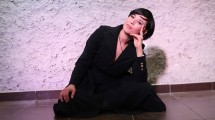Abstract
Torture ruptures boundaries. It is one of the most intense forms of human rights abuse, occurring in the context of relationship, and with the intention to inflict pain on the body. Relationship to one's self, and to others, is often dramatically affected. Integral aspects of the healing process for survivors of torture are to restore relative safety in the body and to rebuild relationship capacity. In this paper, individual dance/movement therapy is introduced as a modality for healing the wounds of torture. The impact of torture on the body, the self, and relationships, and how this can affect treatment using individual dance/movement therapy, is addressed. Dance/movement therapy with an adult survivor is illustrated in a case study. The author concludes that dance/movement therapy, following the experience of torture, can be beneficial in rebuilding an individual's sense of wholeness and self, and in improving interaction skills and relationship capacity.
Similar content being viewed by others
References
Abram, D. (1996). The spell of the sensuous. New York: Random House.
Allodi, F. (1999). The body in political violence. Torture, 9(4), 100–105.
American Psychiatric Association. (1994). Diagnostic and statistical manual of mental disorders (4th ed.). Washington, DC: Author.
Aposhyan, S. (1997). Natural intelligence. Boulder, CO: BMP.
Bartenieff, I. (1972/3). Dance therapy: A new profession or a rediscovery of an ancient role of the dance? Dance Scope, 7,(1), 6–18.
Bartenieff, I. with Lewis, D. (1980). Body movement: Coping with the environment. New York: Gordon and Breach.
Bernstein, P. (Ed.). (1979). Eight theoretical approaches in dance–movement therapy. Dubuque, IA: Kendall/Hunt.
Caldwell, C. (1996). Getting our bodies back. Boston: Shambhala.
Callaghan, K. (1993a, August–September). Group movement psychotherapy with adult survivors of political torture. Paper presented at the Ninth Annual European Symposium in Group Analysis, Heidleberg, Germany.
Callaghan, K. (1993b). Movement psychotherapy with adult survivors of political torture and organized violence. The Arts in Psychotherapy, 20, 411–421.
Chaiklin, S. (1975). Dance therapy. In S. Arieti (Ed.), American handbook of psychiatry (pp. 700–720). New York: Basic Books.
Chaiklin, S., Lohn, A., & Sandel, S. (1993). Foundations of dance / movement therapy: The life and work of Marian Chace. Columbia, MD: The Marian Chace Memorial Fund of the American Dance Therapy Association.
Chester, B. (1994). That which does not destroy me: Treating survivors of political torture. In J.F. Sommer & M.B. Williams (Eds.), The handbook of posttraumatic therapy (pp. 240–251). Westport, CT: Greenwood Press.
Cohen, B.B. (1993). Sensing, feeling and action. Northampton, MA: Contact Editions.
Doerr–Zegers, O., Hartmann, L., Lira, E., & Weinstein, E. (1992). Torture: Psychiatric sequelae and phenomenology. Psychiatry, 55, 177–183.
Genefke, I. (1992). Torture in the modern world. Copenhagen: Rehabilitation and Research Centre for Torture Victims.
Hickson, J., & Kriegler, S. (1996). Multicultural counseling in a divided and traumatized society. Westport, CT: Greenwood Press.
Laub, D. (1992). Bearing witness or the vicissitudes of listening. In Testimony: Crises of witnessing in literature, psychoanalysis and history (pp. 57–74). New York: Routledge.
Levine, P. (1995). Waking the tiger. Berkeley, CA: North Atlantic Books.
Levy, F. (1988). Dance movement therapy: A healing art. Reston, VA: AAHPER.
Lewis, P. (1986). A holistic frame of reference in dance–movement therapy. In Theoretical approaches in dance movement therapy: Vol. I (pp. 279–289) Dubuque, IA: Kendall/Hunt.
Minton, K. (1997). Hierarchical processing, dissociation, presence and sequencing. Unpublished manuscript. Boulder, CO: Naropa University.
North, M. (1975). Personality assessment through movement. Boston: Plays, Inc.
Pfefferbaum, B., & Allen, J. R. (1998). War, children, and youth. Child and Adolescent Psychiatric Clinics of North America: Stress in Children, 7(1), 137–151.
Pool–Heller, D., & Levine, P. (1998). Somatic experiencing training manual. Lyons, CO: The Foundation for Human Enrichment.
Prip, K., Tived, L. & N. Holten. (Eds.). (1985). Physiotherapy for torture survivors: A basic introduction. Copenhagen: International Rehabilitation Council for Victims of Torture.
Salter, A. (1995). Transforming trauma. Thousand Oaks, CA: Sage Publications.
Schmais, C. (1977). Dance therapy in perspective. In K. Mason (Ed.), Focus on dance VII (pp. 7–12). Washington, DC: AAHPER.
St. Just, A. (1999). Introduction to somatic traumatology. Lyons, CO: The Colorado Center for Social Trauma.
Vesti, P., Finn, S., & Kastrup, M. (1992). Psychotherapy with torture survivors. Copenhagen: International Rehabilitation Council for Victims of Torture.
Von Wallenburg, A. (2000). Group psychotherapy for victims of political torture and other forms of severe ethnic persecution. In R. H. Klein, R. & V. L. Schermer (Eds.), Group psychotherapy for psychological trauma, (pp. 265–297). New York: The Guilford Press.
Zeeburg, Niels S. (1998). Torture: A public health puzzle in Europe. Torture, 8,(4a), 21–46.
Rights and permissions
About this article
Cite this article
Gray, A.E.L. The Body Remembers: Dance/Movement Therapy with an Adult Survivor of Torture. American Journal of Dance Therapy 23, 29–43 (2001). https://doi.org/10.1023/A:1010780306585
Issue Date:
DOI: https://doi.org/10.1023/A:1010780306585



